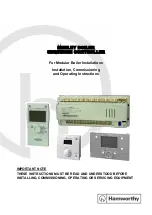
36
PRO-VISION rev.04
PRO-VISION
13.
ALARMS
When an alarm occurs, the Alarm pilot light
turns red and the alarm condition is posted
to the alarm log menu. The table on the right
gives a list of all possible alarm conditions.
Alarm Conditions
Low temperature alarm
High temperature alarm
Critical temperature alarm
Low static pressure (P.E.) alarm
High static pressure (P.E.) alarm
Sensor #x defective
Outside sensor defective
Static pressure (P.E.) sensor defective
Relative humidity (RH) sensor defective
Breaker Hi temperature alarm
Feeder #x run time exceeded
0-10V #x error
Water Meter #x Spill
Amp draw alarm
Empty zone alarm
Another alarm situation occurs when power to
the controller fails. In this case, the alarm relay
is activated. When the alarm relay is activated,
the normally open contact (
) closes.
Backup Thermostat Warning:
Each time the Set Point changes of
4.0°F (2.2°C), the controller displays
a reminder asking to adjust the backup
thermostats. Press any key to make this
warning disappear.
13.1. Alarm Log
The alarm log displays a list of the 75 most
recent alarm events.
Select:
1.
Main menu
Alarms
Alarms
Value
Time
Date
Hi T°
0.0
10:00P
Jan 1 08
Alarms
Alarm Log
T° / S.P.
Temperature Alarms
13.2.
When the average room temperature exceeds
the high temperature alarm setting, a high
temperature alarm is declared; likewise, a
low temperature alarm is declared when the
average room temperature falls below the low
temperature alarm settings. Although these
settings are entered by the user as absolute
values, they are defined based on the tem-
perature set point which mean they are adjust
automatically if the set point changes.
The situation is slightly different when the
outside temperature is greater than the room
set point. In this case, the outside tempera-
ture becomes the reference point (instead of
using the set point as a the reference). This
means an alarm is declared when the room
temperature reaches
Outside Tempe High
Alarm Offset
(the offset being the difference
between the high alarm temperature setting
and the set point). A third parameter, called
the
Critical Temperature
, is defined to continue
monitoring the indoor temperature for high
temperatures. When the indoor temperature
reaches the critical high temperature (defined
as an absolute value), an alarm is declared.
Detection of
Temperature Alarms
Room T°
Alarm
Limits
Hi T°
limit
Hi T°
alarm
Lo T°
limit
Set
Point
Clean Mode Temperature Alarms:
The control-
ler can monitor low temperature alarms when
it operates in clean mode. If this low tem-
perature alarm condition is used, the control-
ler sets off an alarm when the ambient tem-
perature falls below the clean mode’s low
temperature alarm limit.
*Note that this alarm
limit is related to the non-brood set point, which
means it automatically adjusted if the non-brood set
point changes.
Select:
1.
Main menu
Alarms
* T°/S.P.
*A password may be required to access this menu
(see section 4.2.1).
Alarm settings T°/S.P.
To modify use
-
Low T°
Critical T°
Breaker T°
High T°
Non brood
70.0
95.0
0.0
87.0
32.0
Set the following parameters:
2.
Low /High T° —
Select the room temperature
below and above which a temperature alarm
must set off.
Critical temperature —
Set the absolute tem-
perature above which a critical temperature
alarm must set off. Note that this alarm limit can
also be adjusted automatically with time. Refer
to the following section to get further informa-
tion about the critical temperature ramp. *
This
parameter is accessible if the critical alarm condition is
enabled in the Set-up menu (see section 4.4).
Non brood —
Set the temperature below
which a temperature alarm is set off in an
empty zone and during the clean mode.
Breaker T° —
If the controller monitors the
temperature of the main breaker, select the
temperature at which it must set off an alarm.
*
This parameter is accessible if the breaker’s tem-
perature monitoring function is enabled in the Set-up
menu (see section 4.4).
Содержание PRO-VISION
Страница 54: ...PRO VISION NOTES NOTAS...
Страница 55: ...PRO VISION NOTES NOTAS...
















































